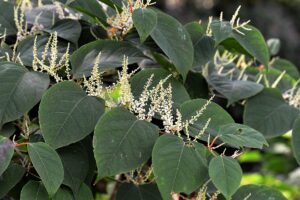Japanese Knotweed (Fallopia japonica) is a growing problem (pun intended!) with recent research by Horticulture.co.uk based on the data from NBAatlas showing a 28% growth of the invasive plant. There is also a large volume of unconfirmed cases so, there could potentially be a large number of cases. Research by Queen’s University Belfast found that invasive species have cost the UK economy over £5 billion and it’s estimated that knotweed has taken £34.12 billion from UK property prices and with the problem only growing it’s not going to go away anytime soon.
Knotweed might be a problem but removal and disposal should become a top priority for homeowners, in fact, if the plant is growing from your property onto neighbours or wildland you may face legal prosecution. A survey on Yougov in 2021 found that of the 907 people asked: 8% didn’t know what the plant was and nearly half were unable to identify the plant when shown photographs.
If homeowners are unable to identify the plant they may not even be aware of the problem they face due to the destructive properties of the plant which can grow up to 10cm a day in summer.
What to look for –
Heart/shovel /shield-shaped leaves which are green when fully grown though will be rolled and red in spring when new. The leaves will ‘zig-zag’ (alternate) grown along the stem. You might find some flecks of red/purple of red veins depending on the season.
The bamboo-like plant will have hollow ‘sticks’ that will snap easily and die back in the winter.
Flowers will be creamy white and are around 10cm long growing in bunches blooming later in the season around late spring/early autumn.
As the plant is female you’ll mostly see the flowers unless it has become a hybrid plant with a native plant that is similar. If you are not sure about the plant it is wise to seek a professional opinion.
Disposal –
It is highly recommended to see a professional to dispose of the plant there have been a few ways which we felt deserved acknowledgement.
Sniffer dogs – Dogs that can smell out the plant is one way to work, the plant has been missed by many a trained surveyor.
Eating – The plant can be eaten and there are a variety of recipes for tea and food whilst ‘tastes like rhubarb’ but we don’t recommend this as plants may be poisonous!
“Another bug hunt” – After some research scientists have found a hungry bug that could devour the plant, time will tell.
Freeze – Not content with researching bugs studies by the National University of Ireland Galway and the University of Leeds found that removing moisture from the plant is an excellent way to kill the plant though the effectiveness of this technique in real-world conditions remains to be seen.
As the plant can be regrown from just a small part of the rhizome (0.7g) which can be smaller than a 1p coin. It’s best to seek professional services to completely eradicate the plant.
How did the plant arrive in the UK?
In late 1840 the plant was bought to the UK by Philipp Franz Balthasar von Siebold and was very popular at the time as an ornamental plant but also gained use as animal feed. Sold in nurseries nearly all the plants we see today are derived from that one sample brought back by Phillip.
Whilst it fitted well with the Victorian decadence it soon fell out of fashion and unfortunately, the plant is notoriously hard to dispose of and soon enough we face the problem of today where it has grown all over the UK.
Selling a property with knotweed
If there is an infestation of knotweed not only will you struggle to get a mortgage you’ll also struggle to sell the property? You will at a minimum require a TA6 Property information form with a plan to tackle the plant.
NAPB members are specialists in quick house sales and have seen all sorts of problems with selling properties. If you are struggling to sell due to a knotweed infestation any of our members would be happy to assist you in selling the property. If you would like advice or more information you can also reach out to the NAPB or the government has some advice on their website. Just remember, when you are selling you will need to make any prospective purchaser aware of the issue as soon as you can.

